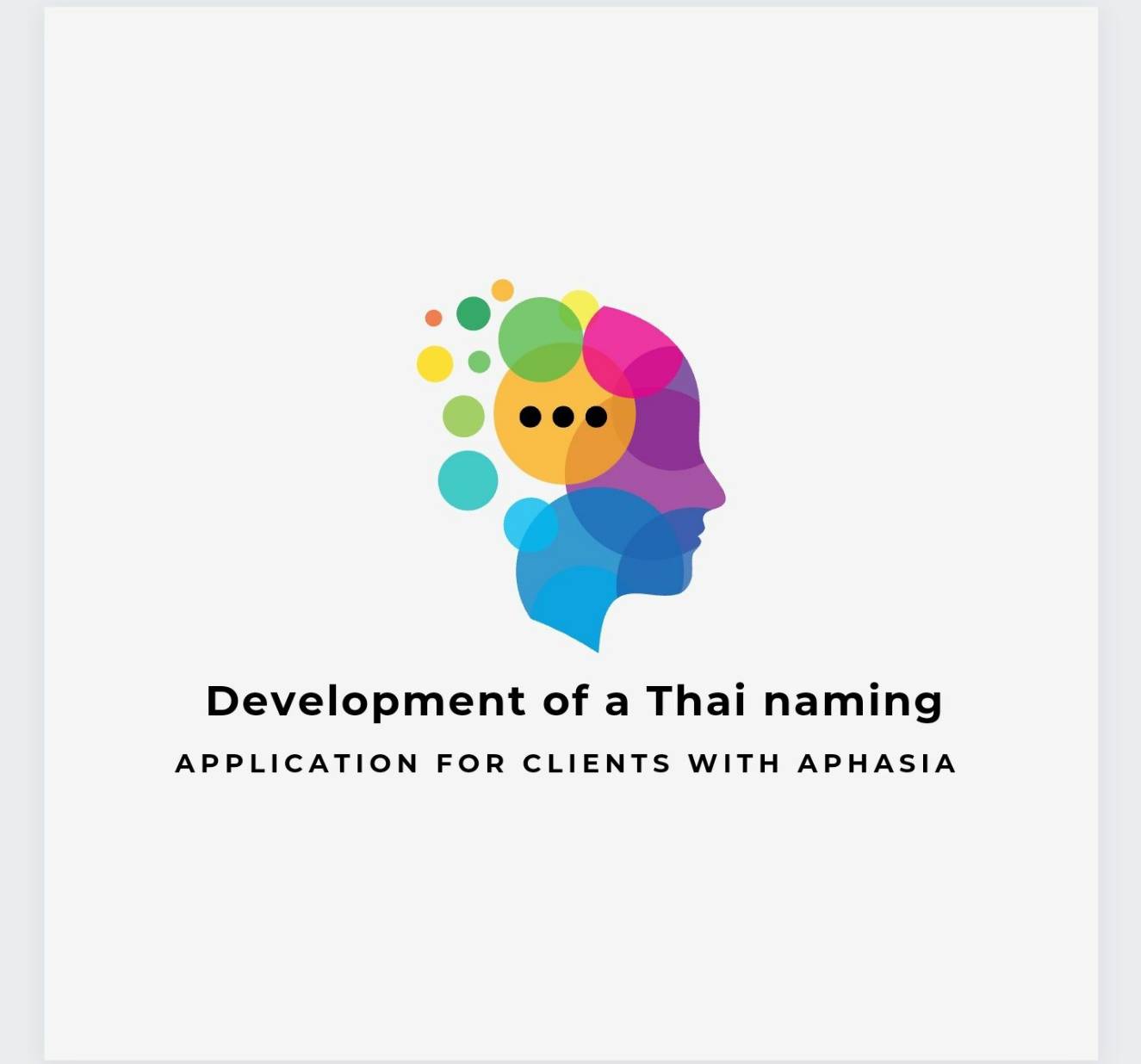Development of a Thai naming application for clients with aphasia
Main Article Content
Abstract
Background: Aphasia, as brain damage resulting from a stroke, results in language impairment, including speaking, auditory comprehension, reading, and writing. Modern technology enhances self-administered recovery training, allowing clients to restore and improve communication.
Objectives: This study developed and assessed the effectiveness of an application on Android mobile devices for language rehabilitation with an emphasis on picture naming.
Materials and methods: A small sample research design was conducted with five primary caregivers and five clients with aphasia. The study was divided into two steps: application development and implementation using a single-subject experimental research design. This research design was divided into three phases: (1) Phase A1, a baseline of 2 weeks before applying the training; (2) Phase B, a training period of 6 weeks; and (3) Phase A2, a withdrawal period of 4 weeks. The total study period was 12 weeks.
Results: The naming rehabilitation application was assessed by visual graphical data analysis, with differences analyzed at each phase interval. After using the application for six weeks, the naming scores of the participants as clients were measured by the Thai Adaptation of the Western Aphasia Battery test (WAB). Results showed increased naming scores while the clients developed their naming skills using the application.
Conclusion: This application enhanced the clients’ naming skills and reduced the time taken to name the words when conducting repetitive stimulation exercises in the form of intensive training combined with various cueing techniques. This application promoted the ability of clients with word-finding difficulties to retrieve words.
Article Details

This work is licensed under a Creative Commons Attribution-NonCommercial-NoDerivatives 4.0 International License.
Personal views expressed by the contributors in their articles are not necessarily those of the Journal of Associated Medical Sciences, Faculty of Associated Medical Sciences, Chiang Mai University.
References
Brady MC, Kelly H, Godwin J, Enderby P. Speech and language therapy for aphasia following stroke. Cochrane Database Syst Rev. 2012.
Jariengprasert C. Speech therapy for stroke patients with aphasia. Vichaiyut Newsletter. 2005; 10: 35-43.
Coppens P. Aphasia and related neurogenic communication disorders. Wall Street Burlington: Jones & Bartlett Publishers; 2013.
Silver LS, Halpern H. Word-finding abilities of three types of aphasic subjects. J Psycholinguist Res. 1992; 21: 317-48.
Lavoie M, Macoir J, Bier N. Effectiveness of technologies in the treatment of post-stroke anomia: A systematic review. J Commun Disord. 2017; 65: 43-53. DOI: 10.1016/j.jcomdis.2017.01.001.
Kleim JA, Jones TA. Principles of experience-dependent neural plasticity: implications for rehabilitation after brain damage. J Speech Lang Hear Res. 2008; 51: S225-S39. DOI: /10.1044/1092-4388(2008/018).
Bhogal SK, Teasell R, Speechley M, Albert M. Intensity of aphasia therapy, impact on recovery. Stroke-a Journal of Cerebral Circulation. 2003; 34: 987-91. DOI: 10.1161/01.STR.0000062343.64383.d0.
Meyer A. Semantic feature analysis application for people with aphasia [Honors Program Theses.]: University of Northern Iowa; 2014.
Ngamsuriyaroj S, Thongsomboon P, Sasipoka N, Srisawasdigate P, Chayaratanasin P. Aphasia Talk Helper on tablet.J Thai Med Inform Assoc. 2017; 1: 9-15.
Sukcharoen S, Saksiri B. Evaluation of the application program of meaningful pictures communication on a tablet for people with Motor Aphasia. J Ratchasuda. 2013; 11: 35-49.
Dardaranda R, Potisuk S, Gandour J, Holasuit S. Thai Adaptation of The Western Aphasia Battery (WAB). Bulletin of Suanprung. 1997; 13(1): 16-21.
Lertprasert T. Elementary basic vocabulary lists. Bureau of Academic Affairs and Educational Standards, Office of the Basic Education Commission (OBEC). [Internet]. 2014. Retrieved October 9, 2018 from http://xn--j3cldb2e9bi2t.blogspot.com/2014/08/ blog-post.html
Pierce JE, O’Halloran R, Menahemi-Falkov M, Togher L, Rose ML. Comparing higher and lower weekly treatment intensity for chronic aphasia: A systematic review and meta-analysis. Neuropsychol Rehabil. 2020: 1-25. DOI: 10.1080/09602011.2020.1768127.
Routhier S, Bier N, Macoir J. Smart tablet for the smart self-administered treatment of verb anomia: Two single-case studies in aphasia. Aphasiology. 2016; 30: 269-89. DOI: 10.1080/02687038.2014.973361.
Doesborgh S, van de Sandt-Koenderman M, Dippel D, van Harskamp F, Koudstaal P, Visch-Brink E. Cues
on request: The efficacy of Multicue, a computer program for wordfinding therapy. Aphasiology. 2004; 18: 213-22. DOI: 10.1080/02687030344000580.
Lavoie M, Routhier S, Légaré A, Macoir J. Treatment of verb anomia in aphasia: Efficacy of selfadministered therapy using a smart tablet. Neurocase. 2016; 22: 109-18. DOI: 10.1080/13554 794.2015.1051055.
Mahakkanukrauh P, Sinthubua A. Basic human anatomy. 1st Edition. Chiang Mai: Department of Anatomy, Faculty of Medicine, Chiang Mai University. 2016.
Roth FP, Worthington CK. Treatment resource manual for speech-language pathology. 4th ed: Nelson Education; 2011.
Phanthumchinda K. Basic neurosciences. 16th Edition. Bangkok: Sinprasit Publishing. 2006.
Hickok G, Poeppel D. The cortical organization of speech processing. Nature reviews neuroscience. 2012; 8: 393. DOI: 10.1016/j.jcomdis.2012.06.004.
Holland AL, Fromm DS, DeRuyter F, Stein M. Treatment efficacy: aphasia. J Speech Lang Hear Res. 1996; 39: S27-S36. DOI: 10.1044/jshr.3905.s27.
Hebb DO. The organization of behavior; a neuropsychological theory. New Jersey: Lawrence Erlbaum Associates; 1949 [reprinted 2002].
Choi Y-H, Park HK, Paik N-J. A telerehabilitation approach for chronic aphasia following stroke. Telemedicine and e-Health. 2016; 22: 434-40. DOI: 10.1089/tmj.2015.0138.
Wall KJ, Cumming TB, Koenig ST, Pelecanos AM, Copland DA. Using technology to overcome the language barrier: the Cognitive Assessment for Aphasia App. Disabil Rehabil. 2018; 40: 1333-44. DOI: 10.1080/09638288.2017.1294210.


